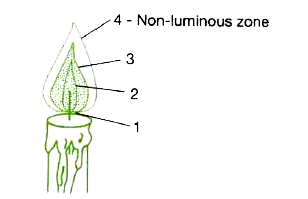Why the flame of an LPG stove and the flame of a Bunsen burner are blue in colour?
Step-by-Step Solution:
1. Understanding the Flames: The question asks about the color of the flames produced by an LPG stove and a Bunsen burner. Both of these flames are noted for their blue color.
2. Identifying the Type of Combustion: The flames of both the LPG stove and the Bunsen burner are a result of complete combustion. This means that the fuel (LPG in the case of the stove, and gas in the case of the Bunsen burner) burns in the presence of sufficient oxygen.
3. Role of Oxygen Supply: In both cases, there is an excess supply of oxygen. This excess oxygen is crucial for ensuring that the combustion process is complete.
4. Result of Complete Combustion: When combustion is complete, it means that the fuel is fully oxidized, producing carbon dioxide and water vapor as the main products, rather than carbon monoxide or soot.
5. Color of the Flame: The blue color of the flame is a direct result of this complete combustion. The high temperature and the presence of specific compounds in the flame contribute to the blue color.
6. Conclusion: Therefore, the flame of an LPG stove and the flame of a Bunsen burner are blue because they undergo complete combustion due to the excess supply of oxygen.
---
Topper's Solved these Questions
- BOOK - PEARSON IIT JEE FOUNDATIONCHAPTER - COMBUSTION AND FLAME EXERCISE - Track Your Learning-I7videos
COMBUSTION AND FLAME
- BOOK - PEARSON IIT JEE FOUNDATIONCHAPTER - COMBUSTION AND FLAME EXERCISE - Track Your Learning-II10videos
COMBUSTION AND FLAME
- BOOK - PEARSON IIT JEE FOUNDATIONCHAPTER - COAL AND PETROLEUMEXERCISE - COMPETITION CORNER48videos
COAL AND PETROLEUM
- BOOK - PEARSON IIT JEE FOUNDATIONCHAPTER - Language of Chemistry and Transformation of SubstancesEXERCISE - Concept Application Concept Application Level - 310videos
Language of Chemistry and Transformation of Substances
Similar Questions
Knowledge Check
- Question 1 - Select One
What is the colour of the flame on heating potassium in the flame of a Bunsen burner?
AGolden-yellowBGray-whiteCPale violetDOrange-red - Question 2 - Select One
The hottest part of the flame of a Bunsen burner is the
ABlue ZoneBZone of complete combustionCZone fo partial combustionDAll parts of the flame are equally hot. - Question 3 - Select One
The elements of group IA provide a colour to the flame of Bunsen burner due to
ALow ionization potentialBLow melting pointCSoftnessDPresence of one electron in the outermost orbit
If you hold a piece of iron wire with a pair of tongs inside a candle flame or a Bunsen burner flame, what will you observe? Will it produce a flame?
View SolutionIn order to understand the structure of a flame, light a wax candle and watch its flame. Carefully note the different coloured zones in the flame. Starting from the base of the flame, a flame has three zones. Check the below figure and try to answer the following question

Why the flame in the outermost zone is blue in colour?View SolutionState with equations what happens when borax is heated on a platinum wire loop and to resulting transparent mass, a mixture amount of CuO is added and the mixture is again heated.
(a) First in the oxidising flame and
(b) Then in the reducing flame of a Bunsen burner ?View SolutionState with equations what happens when borax is heated on a platinum wire Ioop and to the resulting transparent mass, a minute amount of CuO is added and the mixture is again heated first in the oxidising flame and then in the reducing flame of a Bunsen burner?
View SolutionThe flame in this ____ zone is blue in colour.
View Solution

